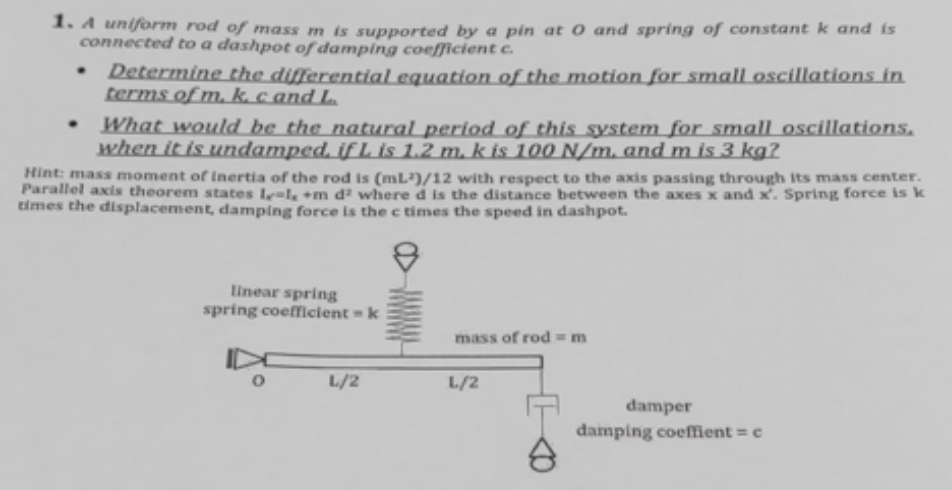1. A uniform rod of mass m is supported by a pin at 0 and spring of constant k and is connected to a dashpot of damping coefficient c. Determine the differential equation of the motion for small oscillations in terms of m., k. c and L What would be the natural period of this system for small oscillations. when it is undamped, if L is 1.2 m. k is 100 N/m. and m is 3 kg? Hint: mass moment of Inertia of the rod is (mL)/12 with respect to the axis passing through its mass center. Parallel axis theorem states le=l, +m d? where d is the distance between the axes x and x. Spring force is k times the displacement, damping force is the c times the speed in dashpot. linear spring spring coefficient = k mass of rod = m L/2 L/2 damper damping coeffient = e
1. A uniform rod of mass m is supported by a pin at 0 and spring of constant k and is connected to a dashpot of damping coefficient c. Determine the differential equation of the motion for small oscillations in terms of m., k. c and L What would be the natural period of this system for small oscillations. when it is undamped, if L is 1.2 m. k is 100 N/m. and m is 3 kg? Hint: mass moment of Inertia of the rod is (mL)/12 with respect to the axis passing through its mass center. Parallel axis theorem states le=l, +m d? where d is the distance between the axes x and x. Spring force is k times the displacement, damping force is the c times the speed in dashpot. linear spring spring coefficient = k mass of rod = m L/2 L/2 damper damping coeffient = e
Elements Of Electromagnetics
7th Edition
ISBN:9780190698614
Author:Sadiku, Matthew N. O.
Publisher:Sadiku, Matthew N. O.
ChapterMA: Math Assessment
Section: Chapter Questions
Problem 1.1MA
Related questions
Question

Transcribed Image Text:1. A uniform rod of mass m is supported by a pin at 0 and spring of constant k and is
connected to a dashpot of damping coefficient c.
Determine the differential equation of the motionfor small oscillations in
terms of m, k. c and L
What would be the natural period of this system for small oscillations.
when it is undamped. if L is 1.2 m. k is 100 N/m. and m is 3 kg?
Hint: mass moment of lInertia of the rod is (mL)/12 with respect to the axis passing through its mass center.
Parallel axis theorem states Ie=l, +m d² where d is the distance between the axes x and x. Spring force is k
times the displacement, damping force is the c times the speed in dashpot.
linear spring
spring coefficient = k
mass of rod m
L/2
L/2
damper
damping coeffient = e
Expert Solution
This question has been solved!
Explore an expertly crafted, step-by-step solution for a thorough understanding of key concepts.
This is a popular solution!
Trending now
This is a popular solution!
Step by step
Solved in 2 steps

Knowledge Booster
Learn more about
Need a deep-dive on the concept behind this application? Look no further. Learn more about this topic, mechanical-engineering and related others by exploring similar questions and additional content below.Recommended textbooks for you

Elements Of Electromagnetics
Mechanical Engineering
ISBN:
9780190698614
Author:
Sadiku, Matthew N. O.
Publisher:
Oxford University Press

Mechanics of Materials (10th Edition)
Mechanical Engineering
ISBN:
9780134319650
Author:
Russell C. Hibbeler
Publisher:
PEARSON

Thermodynamics: An Engineering Approach
Mechanical Engineering
ISBN:
9781259822674
Author:
Yunus A. Cengel Dr., Michael A. Boles
Publisher:
McGraw-Hill Education

Elements Of Electromagnetics
Mechanical Engineering
ISBN:
9780190698614
Author:
Sadiku, Matthew N. O.
Publisher:
Oxford University Press

Mechanics of Materials (10th Edition)
Mechanical Engineering
ISBN:
9780134319650
Author:
Russell C. Hibbeler
Publisher:
PEARSON

Thermodynamics: An Engineering Approach
Mechanical Engineering
ISBN:
9781259822674
Author:
Yunus A. Cengel Dr., Michael A. Boles
Publisher:
McGraw-Hill Education

Control Systems Engineering
Mechanical Engineering
ISBN:
9781118170519
Author:
Norman S. Nise
Publisher:
WILEY

Mechanics of Materials (MindTap Course List)
Mechanical Engineering
ISBN:
9781337093347
Author:
Barry J. Goodno, James M. Gere
Publisher:
Cengage Learning

Engineering Mechanics: Statics
Mechanical Engineering
ISBN:
9781118807330
Author:
James L. Meriam, L. G. Kraige, J. N. Bolton
Publisher:
WILEY